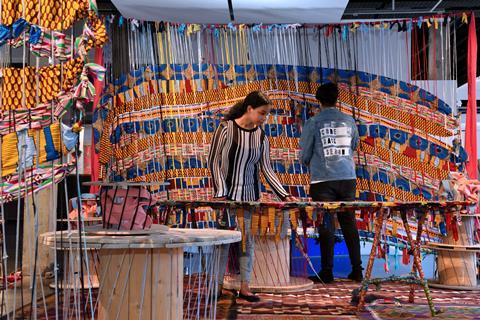Science Gallery London, Guy’s Campus, London
Open until 19 January 2020
Free entry
Further information: london.sciencegallery.com
Walking up the stairs, a poster with a giant upside down smiley greets me – the logo of the London Science Gallery’s latest exhibition. Through artwork – videos, audio pieces, installations and paintings – On Edge looks at how anxiety affects individuals and society.

The first piece visitors see as they walk into the exhibition is an installation that’s all corners, edges, screens and pieces of mirrors. The artwork is rooted in research on depersonalisation disorder, which is described as a sensation of being an outside observer of one’s own body or mental processes. Hidden speakers play interviews with people who suffer from this conditions, but unfortunately the volume is so low that I can barely hear them over the sound of the video playing in next-door’s exhibit.
This second piece is a short film showing a woman standing on a hospital bed, talking about diving and the dangers of drowning. According to its blurb, the video explores the idea of sleep as a strategy for coping with anxiety, drawing parallels between deep sea diving and psychotherapy. While I like the metaphor, this piece was a little too cryptic for my liking.
As I walk further into the exhibition, there are some more accessible pieces. I particularly enjoyed Some People Have No Shoes, a simple audio reel in which the artist lists observations ranging from funny and self-deprecating to serious, highlighting how each of us experiences problems differently. It is one of the exhibits I wanted to spend more time with.

Some exhibits play on the confusing and disturbing feelings anxiety can produce, using jarring musical snippets or chaotic images that certainly don’t fail to give me a taste what anxiety might feel like. One of them, titled The Bad Feel Loops, even comes with a seizure warning that I strongly recommend visitors heed. A pitch-black corridor leads to a darkened threatre where flashing images flicker across a giant screen accompanied by what can only be described as noise.
My favourite piece, right in the centre of the main room, is called Common Thread. Oversized wooden spools sit inside walls made out of woven fabric. Visitors can spend time here, relax and reflect as well as contribute to the tapestry walls by adding a thread or two. The space is also used for events.
While there are some hints at behind the scenes research – a couple of screens invite visitors to sign up for a study on genetic links to depression, and there is a reading area on research around climate change anxiety – there rest of the exhibition remains light on the science. So if you’re after an exhibition that lets you delve into the science of anxiety, you might come out disappointed. But if you’re looking on an artistic take on mental health, this one is for you. Since the exhibition is great value for money – it’s free – so I certainly recommend visiting if you’re in the area.












No comments yet